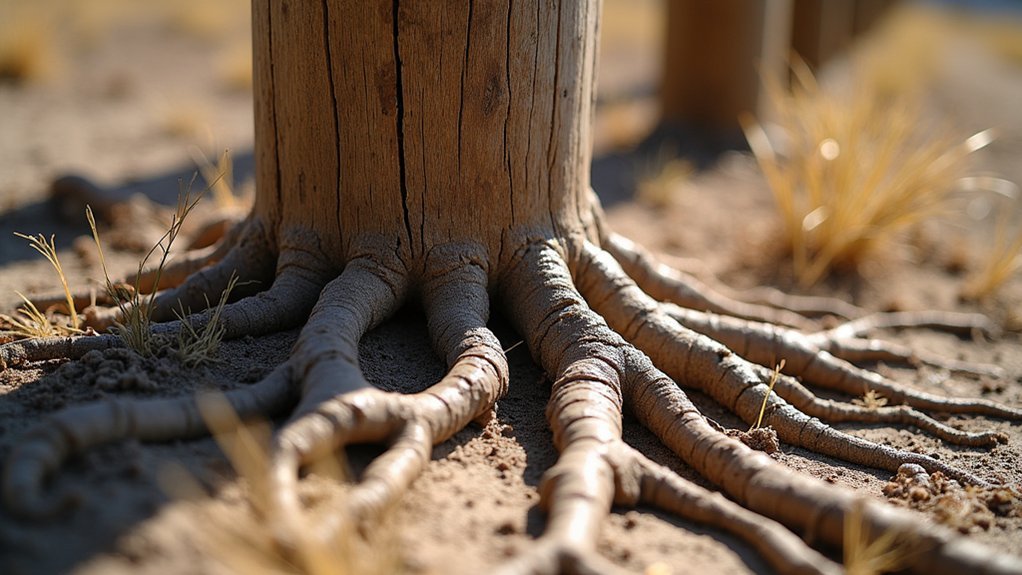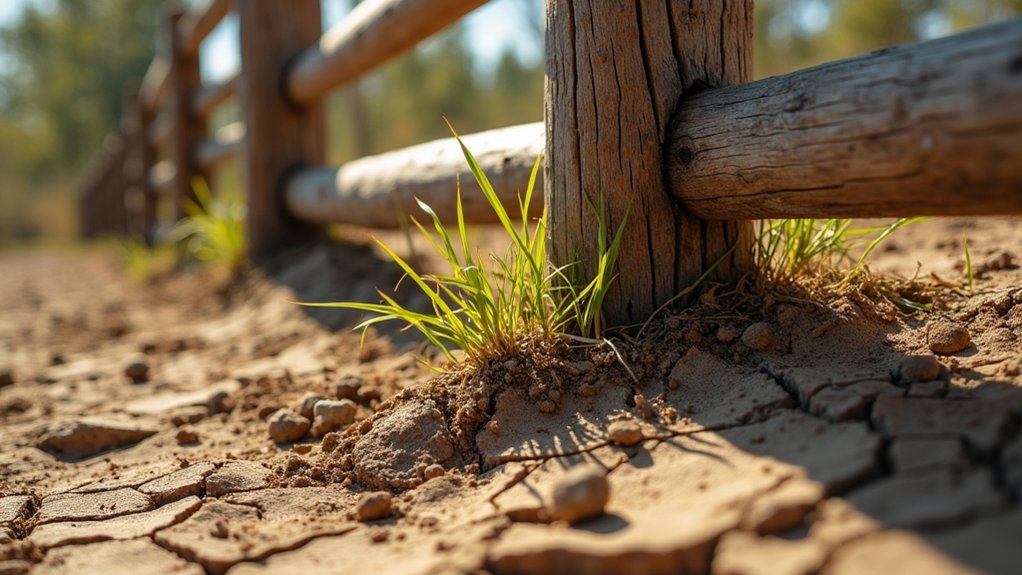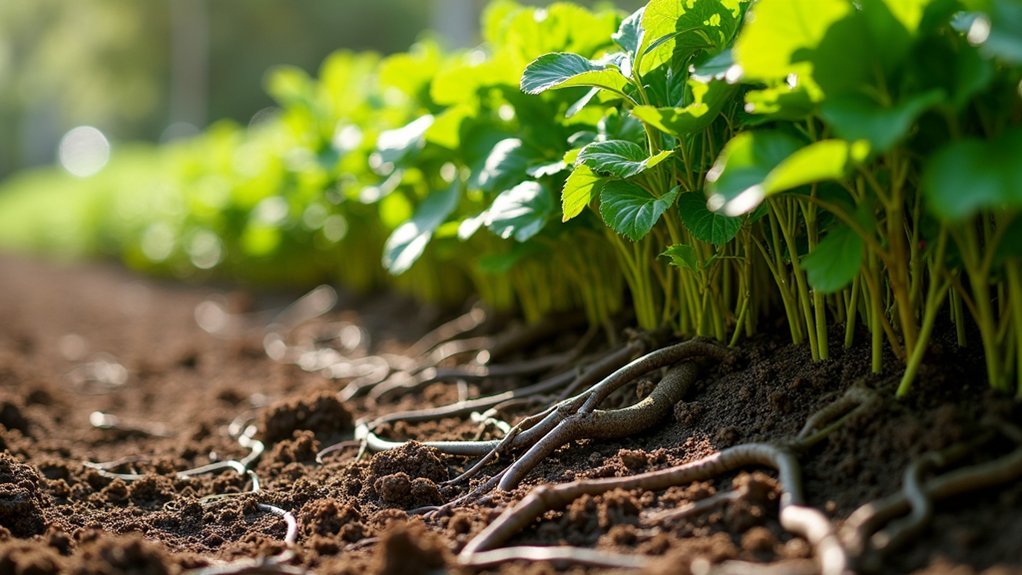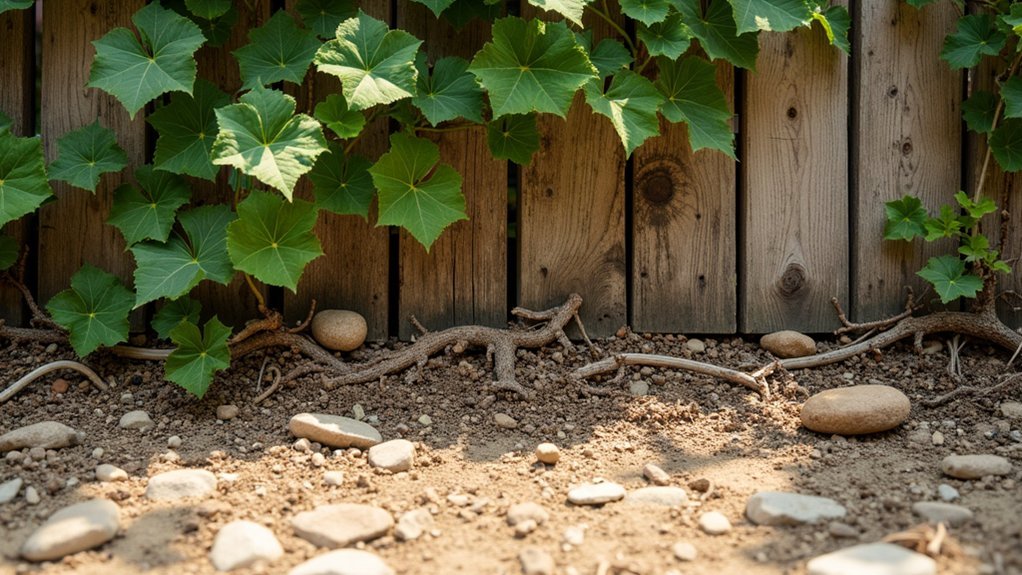To protect fence roots during drought, apply a 3-4 inch layer of mulch around posts while keeping it away from wood. Deep water weekly with 1-2 inches to encourage downward root growth using soaker hoses or drip irrigation. Monitor moisture levels with a meter and adjust watering accordingly. Pay special attention to fences within 50 feet of large trees and those in clay soils. These preventative measures will save you significant repair costs down the road.
13 Second-Level Headings for “Protect Fence Roots During Drought Conditions”

While many homeowners focus on protecting their plants during drought, fence roots often get overlooked despite their essential role in maintaining structural integrity.
Your fence’s stability directly depends on healthy root systems that anchor posts securely in the ground.
Just as trees need strong roots to stand tall, your fence relies on healthy underground systems to remain steadfast and secure.
Effective section headings for a thorough drought protection plan should include “Monitoring Soil Moisture Levels,” “Strategic Watering Techniques,” and “Mulching for Moisture Retention.”
You’ll also want sections on “Preventing Soil Compaction” to guarantee water reaches roots effectively and “Early Warning Signs of Root Stress” to catch problems before your fence becomes unstable.
Each heading addresses a crucial aspect of fence root care during dry conditions, helping you maintain your property’s boundaries even when rainfall is scarce.
Understanding Tree Root Behavior in Drought Conditions
Trees near fences introduce a whole new dimension to drought protection strategies. When moisture becomes scarce, roots don’t just sit idle—they actively search for water, often extending up to 6 feet deep depending on the species and soil composition.
Your fence’s stability becomes vulnerable as tree root systems respond to drought in several concerning ways. Without adequate moisture, clay soils shrink, causing misalignment and structural weakness in nearby fences. Roots compete more aggressively for limited water, increasing the risk of damage to surrounding structures.
Species like sycamores and oaks, with their extensive root systems, exert particularly strong pressure on fences when stressed by drought. As roots rapidly absorb any available moisture, they can cause soil compaction around the root zone, further destabilizing your fence foundations.
Identifying High-Risk Fence Areas Near Trees

You’ll need to examine areas where fences run within 50 feet of large trees like sycamores and English oaks, as these root systems actively seek moisture during drought conditions.
Pay special attention to fences installed in clay soils, particularly in the South East, where soil shrinkage can create alignment issues and vulnerabilities for root intrusion.
During dry periods, focus your inspection on the top 18 inches of soil along fence lines, where the majority of aggressive root growth occurs and poses the greatest threat to your fence’s stability.
Root Danger Zones
To properly protect your fence investment, identifying high-risk areas where tree roots might cause damage is essential. Pay close attention to fence sections within 50 feet of large trees like sycamores and English oaks, as their extensive root growth can travel surprising distances underground.
The most vulnerable zones include:
- The top 12-18 inches of soil where most aggressive root activity occurs
- Clay soil areas that shrink dramatically during drought conditions
- Fence posts showing signs of unusual movement or tilting
- Ground displaying cracks, raised sections, or visible root emergence
During drought, trees in clay-heavy soil desperately seek moisture, often intensifying their root expansion toward your fence line.
Regular inspections of these danger zones will help you identify potential issues before your fence suffers permanent structural damage.
Clay Soil Considerations
While all soil types present challenges during drought conditions, clay soil demands special attention when protecting your fence from invasive roots.
Clay soils expand when wet and contract during dry periods, creating a natural movement that can misalign fence posts and compromise structural integrity.
Be especially vigilant about fences installed within 60cm of trees, as this zone contains over 90% of tree root systems.
Properties in the South East face heightened risk due to prevalent clay soils in the region.
During droughts, trees like sycamore and oak aggressively seek moisture, causing the surrounding clay to shrink dramatically.
Map your property to identify potential problem areas, focusing on fence sections near mature trees.
Regular monitoring becomes essential during extended dry periods when clay soils contract and roots actively search for remaining moisture.
Soil Management Techniques for Root Protection
To protect fence posts from drought damage, you’ll need to implement strategic soil management techniques around vulnerable areas.
Apply a 3-4 inch layer of mulch around fence posts to retain moisture, while using deep watering methods that encourage roots to grow downward rather than laterally toward your fence line.
Enhance your soil’s drought resilience by incorporating organic amendments like compost or well-rotted manure, which improve both water retention and drainage properties.
Mulching for Moisture Retention
During extended dry periods, proper mulching becomes your fence’s best defense against drought stress.
Apply a 2-4 inch layer of organic mulch like wood chips or straw around your fence posts to notably reduce water evaporation from the soil. This protective barrier insulates roots from temperature extremes while gradually decomposing to enrich the surrounding soil.
- You’ll notice visibly healthier fence posts as the mulch prevents soil compaction and allows roots to breathe.
- Your maintenance costs will decrease as properly mulched fences require less frequent replacement.
- You’ll feel relief knowing your property boundary remains secure even during severe drought conditions.
- Your landscape will maintain its aesthetic appeal while neighboring unmulched fences deteriorate.
Remember to replenish your mulch regularly to guarantee continuous protection for your fence’s root system.
Deep Watering Practices
Proper deep watering techniques form the foundation of drought-resistant fence installations. To protect your fence posts, water slowly and thoroughly, applying 1-2 inches weekly directly to the root zone. This encourages roots to grow deeper into soil layers where moisture remains available even during dry periods.
Install soaker hoses or drip irrigation systems around fence lines to deliver water efficiently with minimal evaporation. These systems direct moisture precisely where needed—at the base of posts and supporting vegetation.
Monitor soil moisture regularly using a moisture meter to avoid guesswork. This precision guarantees you’re providing adequate hydration without wasteful overwatering.
Combined with strategic mulching, deep watering practices create a resilient foundation that protects your fence investment through even the harshest drought conditions, maintaining structural integrity when shallow-watered installations might fail.
Soil Amendment Solutions
While deep watering addresses immediate moisture needs, strategic soil amendments create long-term drought resilience for your fence’s root systems.
By enriching your soil with compost or well-rotted manure, you’ll enhance fertility and moisture retention where it matters most.
Regular soil testing reveals specific nutrient deficiencies, allowing you to target amendments precisely.
Consider incorporating biochar to improve soil structure and water-holding capacity during prolonged dry spells.
- Spread mulch around fence bases to lock in precious moisture and shield delicate feeder roots
- Mix organic matter into surrounding soil to boost aeration and water infiltration
- Apply compost to nourish soil microorganisms that support root health
- Add biochar as a long-term investment in your soil’s drought resistance
These soil amendments work beneath the surface, creating a stable environment for root development even when rain is scarce.
Mulching Strategies to Preserve Root Moisture
As drought conditions intensify, effective mulching becomes your fence’s lifeline for root preservation. Apply a 2-4 inch layer of organic mulch like wood chips or straw around fence roots to dramatically reduce soil moisture evaporation. This protective barrier serves multiple purposes in your drought defense strategy.
Your mulching strategies should include regular replenishment as materials decompose. This consistent coverage stabilizes soil temperature, shielding sensitive roots from extreme heat that compounds drought stress.
Beyond moisture retention, mulch prevents soil compaction and creates an ideal environment for beneficial microbes. These microorganisms enhance nutrient cycling within the root zone, strengthening your fence’s resilience during dry spells.
Deep Watering Methods for Established Root Systems

Established fence roots require deep watering techniques to survive extended drought periods. Providing 1-2 inches of water weekly encourages roots to grow deeper into the soil, accessing moisture reserves that surface-level watering can’t reach.
You’ll find the best results using targeted irrigation methods that deliver water directly to the root zone:
- Soaker hoses that slowly release moisture, allowing it to penetrate deeply without wasteful runoff
- Drip irrigation systems that provide precise amounts of water exactly where your fence plants need it most
- Slow-release watering bags that gradually feed thirsty roots over 5-8 hours
- Basin irrigation techniques that create water reservoirs around your fence line for maximum absorption
Use a moisture meter to monitor soil conditions and adjust your deep watering schedule accordingly during severe drought.
Monitoring Root Zones During Extended Dry Periods
During extended dry periods, you’ll need to regularly check your fence’s root zones, looking for signs of stress in tree roots that can compromise structural integrity.
In clay soils, create small basin-like depressions around posts to retain moisture and prevent the shrinking-swelling cycle that damages root systems.
You can prevent permanent root damage by applying a 3-inch layer of organic mulch around fence posts, keeping it several inches away from the wood to discourage rot while maintaining soil moisture.
Tree Root Care
When drought conditions persist, your trees’ survival depends on proper root zone monitoring. Most tree roots occupy the top 12-18 inches of soil, making them particularly vulnerable during dry periods. Effective tree root care requires understanding how soil types affect moisture retention and root health.
- Your trees may be silently suffering with pale, smaller leaves and browning edges signaling distress.
- Clay soils shrink and compact during drought, potentially crushing delicate root systems.
- Cracked drainage systems become targets for desperate roots seeking any water source.
- Proper mulching creates a protective moisture barrier, giving roots a fighting chance.
Check soil moisture regularly and water deeply when needed, focusing on the critical root zone rather than surface watering that evaporates quickly.
Clay Soil Management
Clay soils present unique challenges for root health as drought conditions worsen. Their high shrink-swell capacity causes significant structural changes during dry spells, increasing the risk of root damage as soil compacts and hardens.
To deal with drought conditions effectively, regularly inspect your root zones in clay soil areas. You’ll notice roots competing intensely for limited moisture, which can stunt growth and increase vulnerability to disease.
Implement strategic irrigation techniques like deep watering to maintain moisture levels deep within the clay. This prevents compaction and helps roots access what they need.
Don’t forget to apply a thick layer of mulch around tree bases – this simple step dramatically reduces evaporation and maintains a more stable environment for roots, even as drought persists.
Preventing Root Damage
While clay soil management focuses on the medium itself, your attention must now shift to directly monitoring the root zones during extended dry periods. Most tree root systems exist in the top 12-18 inches of soil, making them particularly vulnerable to drought stress.
To protect your fence and nearby plants during dry spells:
- Watch for warning signs like pale, undersized leaves or browning edges—these indicate your trees are struggling.
- Apply one inch of water weekly throughout the growing season to maintain consistent soil moisture.
- Mulch around tree bases to retain moisture and reduce water competition.
- Inspect fence posts regularly for misalignment, which may signal soil shrinkage affecting root systems.
This proactive approach preserves both your fence integrity and plant health when drought conditions threaten to compromise your landscape’s structural elements.
Preventing Soil Compaction Around Fence Posts
During prolonged drought periods, soil compaction becomes a serious threat to fence stability and the health of surrounding vegetation.
Dry soil hardens around posts, reducing permeability and inhibiting root growth essential for fence stability.
To combat this, apply one inch of water weekly around your fence posts. This maintains moisture levels and keeps soil properly aerated.
Weekly one-inch watering of fence posts preserves soil aeration and moisture balance, extending fence life.
Adding a layer of mulch further preserves moisture and enhances soil structure.
When installing new fencing, position posts at least six to twelve inches away from trees and large plants to prevent root competition and compaction from installation equipment.
Don’t overlook regular inspection of soil conditions around your fence line.
Early detection of compaction allows you to intervene with timely aeration or soil amendments, ensuring both healthy root systems and long-term fence stability.
Natural Barriers to Limit Invasive Root Growth

Beyond soil compaction concerns, your fence faces another challenge during drought: aggressive root systems competing for scarce moisture.
Installing natural barriers around fence foundations can protect your investment while preserving soil health.
Strategic placement of these barriers redirects problematic roots without harming your landscape:
- Gravel or stone barriers create physical boundaries that invasive roots won’t penetrate, protecting your fence’s structural integrity.
- Native plant buffers with less aggressive root systems serve as natural competition, crowding out more destructive species.
- Root barrier materials strategically installed below ground level redirect growth patterns away from vulnerable fence posts.
- Mulch applications retain essential moisture while simultaneously discouraging unwanted root spread.
Regular monitoring enables early detection of potential issues, allowing you to address invasive roots before they threaten your fence’s stability during extended dry periods.
Root Pruning Techniques for Controlled Management
As drought conditions intensify, strategic root pruning becomes essential for protecting both your fence and nearby trees. When dealing with drought, you’ll need to maintain at least six to twelve inches from the trunk when cutting to preserve soil stability and tree health.
Select trees for pruning during their dormant season, which allows the soil and roots to recover before facing dry conditions. Proper root pruning enhances aeration and improves water infiltration where roots extend.
Make sure to prune roots at least several feet from the trunk to maintain stability while reducing competition for poor water resources. This controlled grazing management of root systems encourages deeper growth patterns, making your trees more resilient during extended dry periods while protecting your fence’s integrity.
Drought-Resistant Tree Species for Fence Lines

Selecting the right drought-resistant tree species can dramatically improve your fence line’s longevity while reducing water consumption and maintenance needs.
Eastern Red Cedar and Honey Locust stand out as excellent choices, with deep root systems that access moisture even during extended drought periods.
Native species like the Bur Oak offer exceptional resilience because they’ve already adapted to your local climate conditions.
Native trees like Bur Oak thrive in your specific climate, having already mastered survival in local drought conditions.
Black Walnut provides both drought tolerance and additional benefits through timber and nut production.
- Imagine your fence line standing strong while neighboring properties wither during drought
- Feel the satisfaction of reduced watering needs during water restrictions
- Experience peace of mind knowing your boundary remains intact through dry seasons
- Envision the sustainability of working with nature’s drought-adapted solutions
Drainage Solutions to Protect Against Root Damage
While drought conditions stress trees and shrubs along fence lines, proper drainage solutions remain critical to prevent desperate roots from causing structural damage.
During dry conditions, roots aggressively seek water sources, often infiltrating drainage systems through existing cracks and joints.
Consider implementing a professional CCTV inspection to identify potential root intrusions before they become problematic. This proactive approach can save you significant repair costs down the line.
Water jetting provides an effective, non-invasive method to clear any roots or debris already present in your drainage pipes.
Remember that most tree roots grow horizontally within the top 60 cm of soil, particularly in clay soil areas where moisture fluctuations cause expansion and contraction.
Maintaining consistent soil moisture levels, even during drought, helps prevent roots from desperately seeking water in your drainage system.
Seasonal Maintenance Schedule for Fence Root Care
Beyond drainage solutions, implementing a consistent seasonal maintenance schedule will safeguard your fence from root damage during drought conditions.
Your fence needs more than good drainage—it demands year-round attention to prevent costly drought damage.
Walk your fence line monthly to check for soil erosion and exposed roots, especially during summer’s peak heat.
Your seasonal maintenance should include:
- Spring: Apply 2-4 inches of fresh mulch around fence posts to lock in moisture before summer heat arrives
- Summer: Deep water weekly, providing one inch of water when rainfall is scarce
- Fall: Clear competing vegetation to prevent moisture competition before winter dormancy
- Winter: Use a soil moisture meter to monitor conditions and adjust protection as needed
This proactive approach prevents drought stress before it weakens your fence structure, saving you costly repairs down the road.
Frequently Asked Questions
What Is the Best Material to Cover Tree Roots?
For covering tree roots, you’ll find organic mulches like wood chips or bark are best. They retain moisture, regulate soil temperature, and allow nutrients to penetrate while preventing soil erosion and compaction.
How Do You Protect Exposed Roots?
You’ll protect exposed roots by applying mulch around the base, watering deeply, installing barriers like burlap, monitoring soil moisture regularly, and using root growth enhancers to promote healthier development during drought conditions.
What Happens to Tree Roots During Drought?
During drought, your tree roots extend deeper seeking water while surface roots may die back. You’ll notice your trees showing stress through leaf browning and limb dieback as roots struggle to absorb enough moisture.
How Do You Protect Plant Roots?
You’ll protect plant roots by watering consistently (about one inch weekly), applying mulch to retain moisture, using deep watering techniques, avoiding soil compaction, and monitoring soil moisture regularly to prevent stress from under or overwatering.
In Summary
Your fence’s stability relies on healthy tree roots, even during drought. You’ve learned how to identify risk areas, implement proper soil management, and use mulching to retain moisture. By adopting regular maintenance, strategic pruning, and considering drought-resistant species, you’ll protect both your trees and fences. Don’t wait for problems to appear—apply these preventative measures now to guarantee your property remains secure regardless of weather conditions.





Leave a Reply